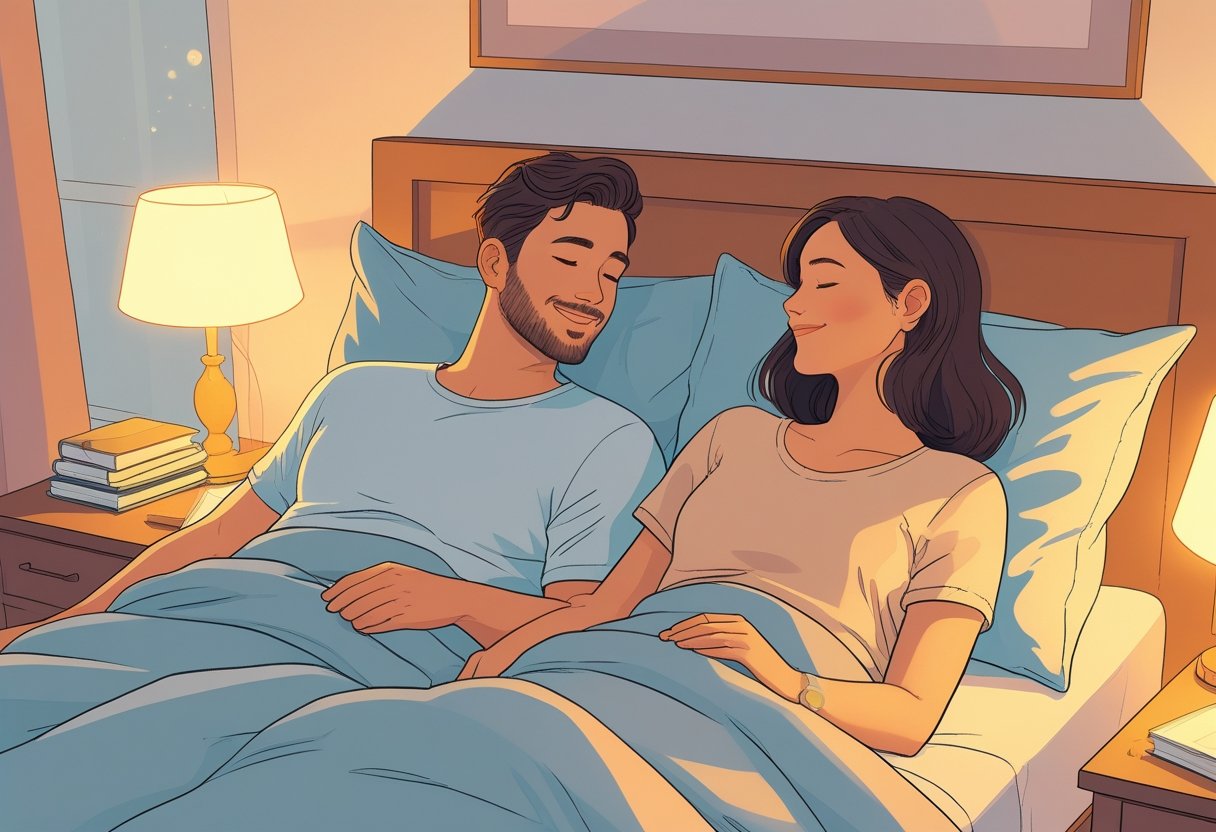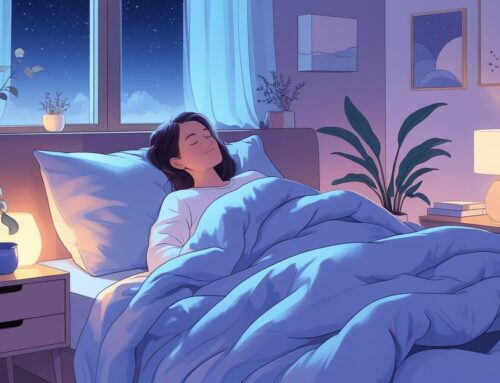Sharing a bed every night says more about a couple than they might realize. The way two people sleep can reflect how close they feel, how much space they need, or how they balance comfort with connection. Some pairs like spooning, which shows warmth and a sense of safety. Others sleep back-to-back, which can signal trust, independence, or just a need for personal space after a long day.
What matters most is finding a position that gives both partners rest without losing that emotional tie. Sleep is not only about the body but also about the bond. When couples notice how they sleep together, it can highlight patterns in their relationship like who reaches out, who pulls away, or who needs balance in both closeness and freedom. Even while asleep, these habits reflect daily life.
As time goes on, sleeping habits usually change. Couples adjust to new routines, health needs, or comfort preferences. What works early in a relationship may shift as life changes. That’s why knowing the most common sleep styles and what they might mean can help couples rest better together. And of course, the mattress plays a big role. The right balance of support and pressure relief helps both people stay comfortable no matter their position.
Key Takeaways
- Sleep positions show how couples feel physically and emotionally with each other.
- Comfort and connection should go hand in hand for better rest.
- Sleep habits change as relationships and needs evolve.
- A supportive mattress helps couples feel comfortable in any position.

Overview of Sleep Positions for Couples

Couples choose sleep positions for comfort, personal needs, and how they connect with each other. The way two people share a bed can show closeness, need for space, or how they deal with stress and temperature at night. Some prefer close contact, while others rest better with distance but still share small touches.
Most Common Couple Sleeping Positions
Spooning is one of the most common choices. Both partners lie on their sides, with one curled around the other’s back. This position signals closeness and physical comfort.
Back-to-back sleeping means lying on your sides facing away. When backs touch, it’s called the cherish position. When there’s no contact, it’s called liberty. Both suggest comfort and independence in the relationship.
Face-to-face is when partners lie close, sometimes touching hands or legs. This shows affection and respect, but it can be too warm for some. Other styles include stomach sleeping, which may reflect stress or a need for space, and the lovers’ knot, where partners hold each other tightly for a short time before adjusting.
Trends in How Couples Sleep
Research shows couples may start out cuddling more closely but need extra space as the relationship grows. Studies note that 54% of adults sleep on their sides, 37% on their backs, and 7% on their stomachs, whether alone or with a partner. Couples who spoon tightly may feel more bonded, while those who separate usually do so for comfort or to stay cool.
More people also share the bed with pets. Over half of pet owners let pets sleep with them. This can feel comforting but may cause lost sleep from movement or noise. In the end, couples balance intimacy with getting enough rest.
Factors Influencing Position Choices
Temperature has a big role in how couples sleep. Warm nights can lead to looser spooning or sleeping apart to avoid heat. Physical comfort also guides position choice. Some adjust to reduce snoring or ease body pain, such as shifting to back or stomach sleeping.
Emotional needs matter too. Stress or anxiety may lead partners to create more space, like sleeping at the edges of the bed. Mattress size and quality also affect comfort, since more room can reduce movement disruptions. Talking openly about sleep preferences helps couples find positions that support both connection and good rest.
Popular Sleeping Positions and Their Meanings
The way couples sleep can say a lot about their comfort and closeness. These positions show how partners balance being near each other and keeping personal space. Some styles reflect intimacy, while others lean more toward independence or comfort.
Spooning and Its Variations
In spooning, one person wraps around the other from behind, acting as the “big spoon.” It’s a cozy, protective style that signals safety and warmth. Many see it as a sign of wanting to stay close during the night.
There are softer versions, like the loose spoon, where couples keep a little distance but still touch. It feels less restrictive and allows easier movement. The chasing spoon happens when one person pulls away slightly, which could be playful or a hint that they want more room. Though well-known, full spooning through the night is less common, with only about 1 in 5 couples sticking to it.
Back to Back Sleeping
When partners sleep back to back but stay in contact, it’s called the back kiss. This style suggests comfort and trust, and it shows that closeness doesn’t always require facing each other. It’s especially common in early stages of a relationship.
If sleeping back to back with space in between, it’s known as liberty lovers. This shows a mix of independence and connection, and many find it helps them rest better physically. But if a couple shifts to this position unexpectedly, it may be worth asking if one of them needs more space, physically or emotionally.
Face to Face Positions
Sleeping face to face while intertwined shows deep emotional connection. Couples in this style usually value closeness and communication. It’s an intimate way to sleep, though it can get uncomfortable over time since it restricts movement and breathing.
Face to face without touching, however, might suggest something different. It can signal distance in the relationship or that one partner wants more attention. The meaning depends on the overall dynamic between them.
Intertwined and Cuddling Styles
Positions with arms or legs tangled together, such as the nuzzle or the leg hug, show affection and a desire for physical connection. These positions encourage closeness and can strengthen bonds through touch. The nuzzle, where one rests their head on the other’s chest, signals care and trust. While tender, it can feel less comfortable for long stretches of sleep. Leg hugging can be one-sided, which may show a difference in emotional needs. But when both enjoy it, it reflects balance and shared affection.

Relationship Insights and Psychology
Couples’ sleeping positions can tell a lot about how they feel toward each other. The way two people rest at night isn’t random, it’s a quiet signal of comfort, trust, and connection. These habits reveal pieces of personality and the emotional rhythm of the relationship.
What Your Sleeping Position Says About You
The Spoon position shows closeness and care, where one partner literally has the other’s back. Back Kissers, who sleep back-to-back but touch slightly, balance independence with connection. Liberty Lovers, who sleep apart with little contact, show a sense of security because both partners feel free while still emotionally tied. On the other hand, stomach sleeping may suggest stress or unease, while a Space Hog stretched across the bed can hint at dominance or selfish behavior.
Emotional Connection and Body Language
Body language in sleep can be as telling as what couples say when awake. Positions with more physical contact, such as the Tangle or Nuzzle, often point to deep emotional or physical closeness. These are common in newer relationships or when couples rekindle intimacy.
Sleeping with less contact doesn’t always mean distance. For example, the Loose Spoon, where both face the same way but with space between, shows trust and comfort. Movements like the Chasing Spoon, when one follows the other, may reflect a quiet need for closeness or a desire for space. These small details can highlight relationship dynamics that partners might not discuss out loud.
How Sleeping Positions Reflect Relationship Stages
Sleeping styles usually change as the relationship grows. Early on, couples may choose tight or intertwined positions, like the Tangle, to feel secure and reassured. With time, many shift to more relaxed positions such as the Loose Spoon or Unraveling Knot, which balance space and connection.
Long-term partners often prefer Liberty Lovers or Back Kissers, which show maturity and respect for both closeness and independence. But sleeping far apart with no contact at all can sometimes reflect unresolved conflict or emotional distance. Paying attention to these shifts can help partners understand their needs and strengthen their bond.

Pros and Cons of Shared Sleep for Couples
Sleeping side by side can be comforting. It builds a sense of closeness and ease that many couples value. At the same time, it can bring its own set of problems like tossing, turning, or small habits that disturb rest. How partners handle these differences can shape both their nights and their connection during the day.
Physical and Emotional Benefits
There’s a reason many people sleep better with someone nearby. Having a partner in bed creates a layer of safety, almost like a quiet reassurance that lowers tension. That comfort alone can help the body reach deeper stages of rest.
Touch also plays a big part. A simple hand on the arm or brushing of feet releases oxytocin, the hormone that calms the mind and encourages trust. In some studies, couples lying together show heartbeats that fall into rhythm, a reminder of how closely the body responds to shared presence. Beyond the science, there’s the emotional side. Waking up next to someone can ease worries, reduce the weight of stress, and open the door to better communication. It’s not just about the sleep itself, it’s about what that nightly closeness means for the relationship as a whole.
Potential Challenges and Solutions
Of course, sharing a bed isn’t always smooth. Different work hours, loud snoring, or one partner shifting through the night can all disrupt sleep. Even something as simple as one liking the room warm while the other prefers it cool can create tension.
Space can also be an issue. A bed that feels cramped may cause overheating or limit movement, which leads to restlessness. Couples who find a balance, whether it’s sleeping back-to-back, loosely touching, or giving each other more room, rest easier without losing the feeling of connection.
The good news is that small changes can help. Earplugs and eye masks block distractions. Separate blankets solve temperature disputes. And most importantly, open conversations about sleep needs prevent resentment from building. Adjusting routines or setups may take time, but it’s usually enough to restore comfort and peace.

Unique Considerations in Couples’ Sleeping Styles

Couples develop sleep habits that go beyond simple positions in bed. These habits shape comfort, intimacy, and how well they rest together. Some feel better without clothes, some prefer constant contact, and others figure out ways to handle different sleeping hours.
Sleeping Naked Together
For some couples, sleeping naked creates a stronger bond. Skin-to-skin contact may release oxytocin, which is linked to comfort and closeness. It can feel natural and calming when both partners enjoy it. Still, not everyone finds it practical. One person may need more blankets while the other gets too warm. Small changes, like adjusting bedding, can help. At the end of the day, it’s not about being naked, it’s about whether both partners feel comfortable enough to rest.
Sleeping on Top of Someone
Some couples like lying on top of each other after sex or during quiet moments. It feels safe, affectionate, and shows trust. For many, it’s less about sleep and more about connection. But keeping that position all night usually doesn’t work. The person on the bottom may feel numbness or strain from the weight. Most couples naturally shift into easier positions once it’s time for real sleep. This habit shows up more in the early stages of love, when passion and closeness are strongest.
Sleeping at Different Times
Not every couple goes to bed together. One may fall asleep earlier while the other stays up. That can mean less shared time before sleep. Still, it doesn’t have to cause problems. Some couples find small rituals, like talking before one partner drifts off, or reconnecting later in the night. Different schedules are usually about personal rhythms or work demands, not a lack of closeness.
Tips for Finding the Best Sleep Position as a Couple

Finding a comfortable sleep position means balancing closeness and personal space, addressing physical needs, and staying flexible as things change. Partners need clear communication and a bit of trial and error to find what works best for both.
Adjusting Positions for Comfort
Couples usually shift through different sleep positions to stay comfortable. Sleeping back-to-back without touching gives each person space but still feels connected. Spooning feels warm and close, though it can lead to sore muscles if you stay in it too long.
Pillows can ease strain on the body. A pillow between the knees when lying on your side can take pressure off the hips. If one person wakes up stiff or keeps changing positions, it may be time to rethink the setup. Blanket issues are common too. Using separate covers helps if one person pulls too much during the night. Small fixes like adjusting sleepwear or room temperature also make it easier for both to rest well.
How to Sleep with Someone New
Sharing a bed with a new partner can feel tricky at first. Different habits and comfort levels come into play. A little cuddling before sleep builds connection, then moving into a side-by-side position gives each person breathing room. Clear conversations help avoid small problems turning into big ones. Talking about things like preferred sleep positions, snoring, or restlessness sets expectations. Trying relaxed postures such as a “loose spoon” or “paper dolls” style gives closeness without too much contact.
The bedroom setup matters too. Separate bedding or going to bed at slightly different times can reduce interruptions and help both partners fall asleep more easily.
Improving Sleep Quality Together
Bedtime routines help in winding down. Reading, meditating, or simply sitting quietly together can set the mood for rest. These small habits bring calm before sleep. If snoring or health issues interfere, it helps to deal with them early. Sometimes that means a doctor’s visit or changing bedding arrangements. A mattress that matches each body type also plays a big role in how well both partners sleep.
And as time goes on, staying open to changes keeps things easier. Needs may shift, and being flexible keeps comfort and connection strong. A few simple adjustments can keep rest peaceful for both.
Best Mattress for Couples with Different Sleeping Positions
Couples who rest in different ways need a mattress that works for both. The right option should give support but also feel soft enough to reduce pressure. It has to fit side, back, and stomach sleepers without causing discomfort. Hybrid mattresses work well because they mix soft comfort layers with durable coil support. This type of design helps take stress off the joints while keeping the spine aligned. It balances comfort and firmness in a way that suits more than one style of sleeping.
A mattress worth considering is the Brooklyn Bedding Sedona Elite. It has a medium feel at about 5 out of 10, which suits side and back sleepers up to around 230 to 300 pounds. The design includes a cool GlacioTex+ cover, copper-infused memory foam, micro-coils above Ascension coils, and a dense foam base that holds up over time. This setup brings relief to shoulders and hips, keeps airflow steady for hot sleepers, and reduces motion transfer so partners don’t disturb each other. Edge support is decent, allowing use of the whole bed, though not as reinforced as some stronger models.
The Sedona Elite works well for couples who change positions through the night. Its mix of pressure-relief and steady support gives both comfort and balance. In the end, it’s a cooling, durable mattress that helps couples with different sleeping needs rest well together.

Frequently Asked Questions
Couples’ sleeping positions can say a lot about their connection. Some ways of sleeping bring closeness, while others focus more on comfort and rest. These choices can also show if someone feels pain, or they can reflect changes in how partners relate to each other.







